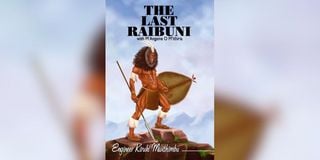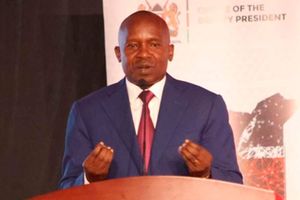Meru warrior Angaine who frightened bully colonial DC

The cover of the book The Last Raibuni.
What you need to know:
- M’Angaine O M’Ithiria was a tribal warrior who later collaborated with the colonial government.
- He was the father of Jackson Angaine who became the political kingpin of the Mt Kenya region.
Book: The Last Raibuni
With M’Angaine O M’Ithiria
Author: Engineer Kiruki Mwithimbu
Reviewed: By Khakhudu Agunda
In every community and epoch, some individuals have emerged and gone on to do great things, contributing to progress and prosperity.
However, as their success stands out, even these heroes, human as they are, have their weaknesses — their Achilles’ heel.
For the Meru community of the Mt Kenya region, there was M’Angaine O M’Ithiria in the 19th century through whom the author, Engineer Kiruki Mwithimbu, chronicles his family’s great achievements.
This is the story of a man, who in the colonial days did something that was daring to the extreme.
In September 1908, he confronted a bully colonial District Commissioner (DC). And an apple does not fall far away from the tree.
His own son, Jackson Angaine, as part of independent Kenya’s delegation to London in 1965, also displayed the fiery tempo of a Meru Raibuni, when he flatly rejected a British plan to get Kenyans to pay for their own land through a World Bank loan.
He shot up from his seat and screamed: "You are giving us money to buy our land from your people…No Way!"
The Last Raibuni is about M’Angaine’s development from a tribal warrior to his collaboration with the colonial government that earned him the coveted Member of the British Empire (MBE) title, until his tragic end, when he took his own life.
He was the father of Jackson Angaine, a man, who would during the struggle for independence in the 1950s play a behind-the-scenes role with the Mau Mau and later emerge as the political kingpin of the Mt Kenya region and a senior Cabinet minister.
This historical account sets the context for the Angaine family story, and it is woven with dexterity by Engineer Mwithimbu.
The Angaine family
It is an interesting peek into the Angaine family that would in a century straddle the Mt Kenya region like a colossus. The author sees the name Angaine was a combo of three characters, forming a trinity of sorts.
There was M’Angaine, the father, Nto-angaine the son, and Angaine the fox. M’Angaine, born in the last quarter of the 19th century, would later earn the title Mugwe O Meru.
The author takes the reader deeper into the community to appreciate its organisation, cultural practices and sustenance through marriage, childbirth and execution of different roles.
But the story of the man and his family, however, somewhat fades away in the early pages, unveiling an anthropological study. Women are not mentioned by name, but are key in the survival of the family.
There is a treasure trove of information that would make the current family planning programmes look shallow.
Breastfeeding meant that the mother would not engage in sex for up to four years, giving ample time to raise healthy children. But the men did not have to wait that long. Polygamy was the rescue for men.
It is a fascinating tale of a community in the remote mountain region that would come into contact with European explorers and colonialists and also be influenced by international events such as the First World War. Well-captured is the Merunisation of words that later became common names. The Meru name Kaaria came from Carrier Corps of the First World War (1914-18).
The name Ndinguri came into the Meru cultural vocabulary through returning fighters fascinated by the exploits of Frenchman Charles de Gaulle, then a 16-year-old, who led daring missions against the Germans in Paris.
He later became a General in the French Army and a top national leader. The corruption of De Gaulle yielded the Meru Ndinguri.
M’Angaine O M’Ithiria was a tough youthful warrior, who, in 1905, saw the birth of his first son, Jackson. This was three years before the first colonial DC, Edward Butler Horne, arrived in Meru.
Key historical moments
His star continued to shine through his collaboration with DC Horne, nicknamed Kangangi by locals because of his propensity for "wandering aimlessly all over the land".
They were mistaken, as he was actually scouting and surveying where roads and future towns would be built.
The colonisation of Meru was gradually executed together with that of the rest of the Mt Kenya region. It started with Fort Hall (Murang’a) in 1901, Fort Nyeri, 1904, Fort Embu in 1906, and Fort Meru in 1908.
Other key historical moments include the 1904 Embu massacre, following the killing of a young Mzungu District Officer.
The warrior who speared him to death felt proud, but would be deflated on finding out that he was uncircumcised. To the Embu warrior, it simply meant that he had killed a child, which none would be proud of.
The author spices up the story with anecdotes and gems derived from excellent research. DC Butler, who arrived in Meru in 1908, was a 28-year-old maverick and adventurer.
In Embu and Meru, he became Bwana Muroko, a corruption of the Kiswahili, Bwana Mdogo. This was the bully M’Angaine first met in September 1908, when they faced off in a battle of wits.
When World War 1 broke out in 1914, M’Angaine, as the local assistant to the DC, conscripted warriors into the Carrier Corps. In 1928, he was promoted to a Senior Chief. He later became the Paramount Chief. In 1946, he was awarded the MBE.
In an intriguing twist in the story, rather than succumb to the indignity of signing off his community’s land, the patriarch used his service rifle, to shoot himself in the head in 1947.
Immense executive powers
In January of 1926, his son, M’Ncebere, had joined Kaaga Primary School, among the very first group of Meru boys at the missionary centre locals called Micheni e Kaaga. M’Chebere O M’Angaine was baptised Jackson M’Chebere O M’Angaine, later truncated to Jackson Angaine for simplicity.
In 1933, Jackson did his Primary Eight exam at Kaaga and became the first Meru to go to Alliance. After Form 2, he attended the famous Achimota College in Ghana, bringing home a teaching diploma just before the Second World War broke out.
In 1940, he quit teaching and joined the army. Being an educated son of a chief, he did not need to go to war, but as the son of a Meru Raibuni, he had to prove his mettle.
In the KAR, he saw action in Burma and Yemen as a Sergeant-Major. When they discovered that he had absconded from a government job to join the army, he was shipped back to Mombasa presumably to resume teaching, which he never did.
In June 1963, Kenya attained independence with Kenyatta as the Prime Minister. Two years later, Angaine was appointed the Minister of Lands and Settlement.
With immense executive powers under his belt, Angaine the fox would metamorphose into a leopard. He was shrewd, calculating and with a voracious appetite for land.
After his defeat in the 1979 elections to Nteere Mbogori, he retired to his Kararu Farm near Nanyuki Town.
True to his middle name, Harvester, out of Parliament for the first time since 1962, he devoted his energies to growing wheat and barley.
But he would bounce back and serve again in Parliament from 1988 to 1992.
He passed away on 24th February 1999, aged 94, ending the century-old Angaine dynasty that began with the Ramare Raibuni in 1896 and was signed off with ‘King of Meru’ Jackson Angaine.
Kiruki Mwithimbu, an engineer, is an almnus of Meru School and Kagumo High School. He is also the author of ‘Living on the Edge’, kirukimwithimbu@@gmail.com. The book is available at NURIA Bookshop, Bazaar Plaza, opposite Khoja Mosque, PEAKS Hotel, Nanyuki and Mathaga Bookshop Kikuyu. [email protected]




